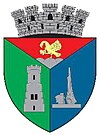Carei
|
Carei Nagykároly |
|||
|---|---|---|---|
| Municipality | |||

The Károlyi castle in Carei
|
|||
|
|||
| Nickname(s): Town of the Károlyis | |||
| Location of Carei | |||
| Coordinates: 47°41′2.28″N 22°28′0.73″E / 47.6839667°N 22.4668694°ECoordinates: 47°41′2.28″N 22°28′0.73″E / 47.6839667°N 22.4668694°E | |||
| Country |
|
||
| County | Satu Mare County | ||
| Historical region | Crișana | ||
| Status | Municipality | ||
| Settled | 1264 | ||
| Incorporated | 1717 | ||
| Government | |||
| • Mayor | Jenő Kovács (Democratic Union of Hungarians in Romania) | ||
| Area | |||
| • Total | 102 km2 (39 sq mi) | ||
| Population (2011) | |||
| • Total | 21,112 2,011 census data | ||
| Demonym(s) | careian, careiancă (ro); nagykárolyi, károlyi (hu) | ||
| Population by Ethnicity | |||
| • Hungarians | 54.8% | ||
| • Romanians | 40.4% | ||
| • Germans | 2.4% | ||
| • Roma | 2.3% | ||
| Population by Religion | |||
| • Roman Catholics | 37.5% | ||
| • Romanian Orthodox | 33.3% | ||
| • Reformed | 20.6% | ||
| • Greek Catholics | 6.2% | ||
| • Other or none | 2.4% | ||
| Time zone | EET (UTC+2) | ||
| • Summer (DST) | EEST (UTC+3) | ||
| Climate | Cfb | ||
| Website | http://www.municipiulcarei.ro/ | ||
Carei (Romanian pronunciation: [kaˈrej]; Hungarian: Nagykároly, Hungarian pronunciation: [ˈnɒckaːroj]; German: Grosskarol/Großkarl; Yiddish: קראלי (Krole or Kruli), Turkish: Karolvar) is a city in Satu Mare County, northwestern Romania, near the border with Hungary.
The city was named after an old noble family, the Károlyi. Carei administers one village, Ianculești (Hungarian: Szentjánosmajor).
In 1262, in a document, Karul appears as a name of a person, but the etymology of the word can be traced back to the name of a bird karul-karvaly, taken from the ancient Turkish language. The bird that can be found on the coat of arms of the Karolyi family.
King Louis I of Hungary permitted the organization of weekly market gatherings in Carei in 1346, as a result of the military achievements of the Károlyi family. The development of the trade in the region stimulated the wealth and expansion of the town. In the 14th century, the locality was a small settlement with a few streets built around the domain of the noble Károlyi. Wars, plague and famine during the Middle Ages decimated the population and the Károlyi family took steps toward bringing Swabians on their lands. During the 16th and 17th centuries, Carei is often devastated by wars. The town and the surroundings villages suffered the greatest losses during the anti-Habsburg riot, led by Francis II Rákoczi. The first group of colonists came in 1712, opening a century-long period of gradual colonization with Swabians, Slovaks, and Jews. Between 1712-1774,466 Swabian families are settled down in Carei, forming two districts in town. Effects on cultural and social life began to show: in 1727 the Piarist Gymnasium was established, in 1754 the first typography was built, and in 1756 a drugstore was opened.
...
Wikipedia



